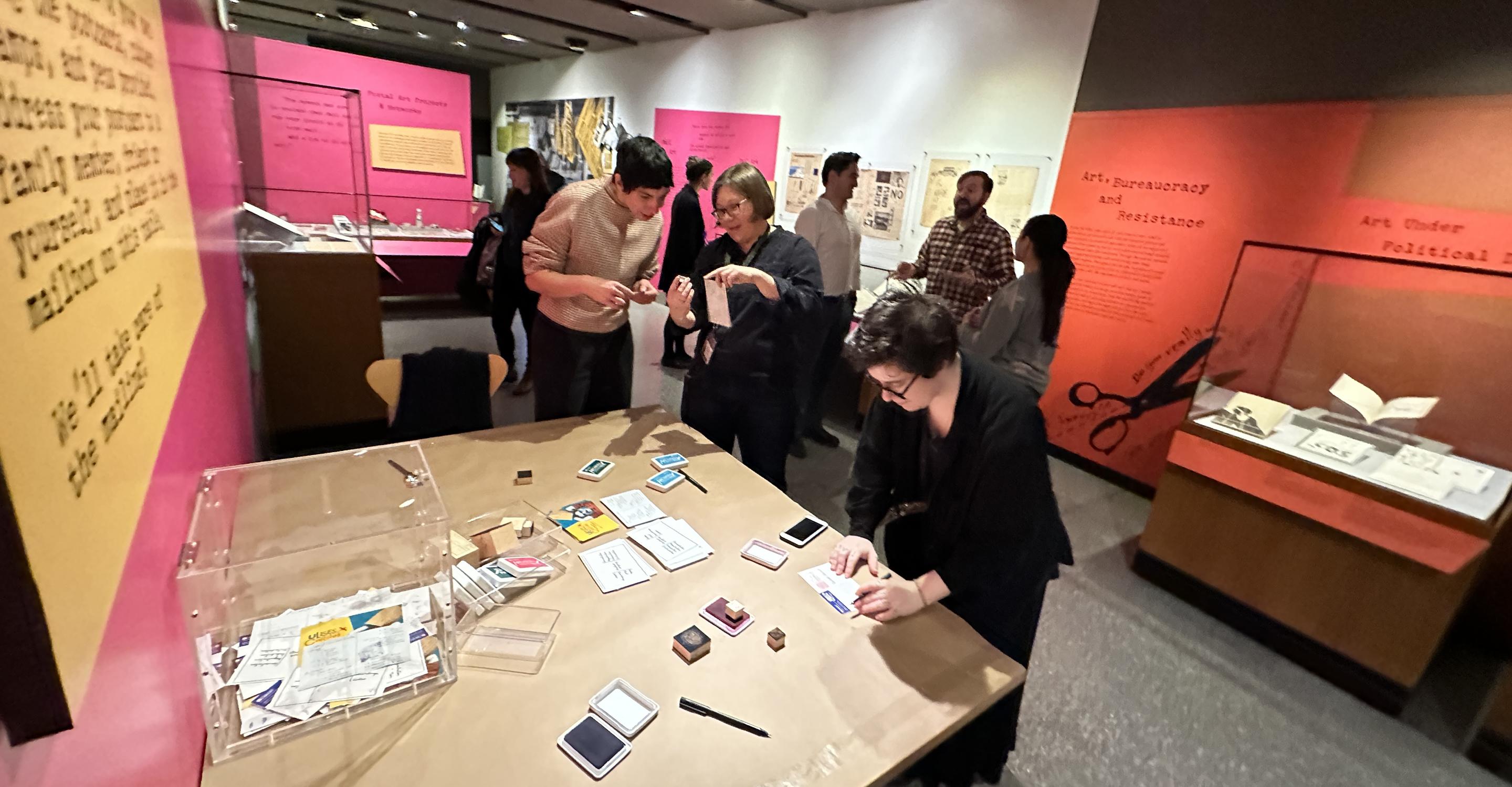Javier Rivero Ramos *23 Co-curates Ulises Carrión: Bookworks and Beyond at Princeton’s Firestone Library

Co-curated by recent Ph.D. graduate Javier Rivero Ramos *23 with Princeton University Library’s Metadata Librarian for Special Collections Sal Hamerman, Ulises Carrión: Bookworks and Beyond is on view in the Ellen and Leonard Milberg Gallery at Firestone Library through June 13, 2024.
The exhibition celebrates Mexican-born artist Ulises Carrión Bogard, who reconceived the book as a fundamentally collaborative work that is at once material, symbolic, and social. “Carrión was interdisciplinary before that was a thing,” said Rivero Ramos. His practice included artists’ books, mail art, sound poetry, performance, curating, and archiving.
Hamerman and Rivero Ramos each bring acute and complementary expertise to the exhibition. “My own dissertation was focused on mail art in the context of Latin America,” said Rivero Ramos, “so I knew the objects well, and I had a take on them.”
Javier Rivero Ramos presents a case housing artifacts related to Carrión’s index (Photo/Kirstin Ohrt)
Hamerman wrote their Master’s thesis on Carrión and brought a focus “on the artist books and networks of artists that facilitated this burst of energy within artist publishing and publishing as a means of creating artwork.” Weaving together their perspectives, “We were able to develop the intellectual side of the show in a very organic way,” said Rivero Ramos.
Carrión represents the largest United States retrospective exhibition of his work to date, including several iconic objects purchased specifically for the exhibition and featuring holdings drawn from the Marquand Library of Art and Archaeology and PUL’s Special Collections.

Ulises Carrión’s index of contacts (Photo/Kirstin Ohrt)
Among newly acquired objects is Carrión’s personal Rolodex. The set of index cards tracked not only addresses for Carrión’s contacts but also recorded which publications he had sent and notes about the status of relationships like “people I used to like.”
“When you organize a show,” said Rivero Ramos, “you kind of stir the bottom of the water, and more things come to the surface...You create a moment that you hope will galvanize the career of an artist. We already had a substantial collection. And now it’s really expanded.”
“When you organize a show, you kind of stir the bottom of the water and more things come to the surface....You create a moment that you hope will galvanize the career of an artist.” —Javier Rivero Ramos *23
Professor Irene Small Moderates Scholarly Panel

Irene Small moderates the scholarly panel in the Chancellor Green Rotunda (Photo/Kirstin Ohrt)
On March 6, A&A co-sponsored a discussion on the exhibition in the Chancellor Green Rotunda moderated by Irene Small with Zanna Gilbert, Senior Research Specialist at the Getty Research Institute, and Mónica de la Torre, Distinguished Lecturer and Chair in Literature at Brooklyn College, joining Hamerman on the panel. Examining Carrión through each panelist’s uniquely tuned lens made for a rich discussion of his innovative work.

As a librarian, Hamerman examined Carrión as a mediator of interactions with books who applied “cultural strategies” to question the limits of artistic and literary work. To quote Carrión himself, “I believe art as a practice has been superseded by a more complex, more rigorous, and richer practice: culture.” Carrión framed the archive as artwork, said Hamerman, citing Carrión’s book In Alphabetical Order, 1979, which binds together a series of photos depicting personal Rolodexes, including Carrión’s own. Among objects displayed in the current exhibition in Firestone, Carrión’s aforementioned index of 1350 names included annotations like “People I’ve Met; People I used to like; Artists; Non-Artists; My Best Friends—People I Love; People I Admire; There Has Been A Change in Our Relationship of Late.” Hamerman called it a “paper database,” representing the back end to mail art’s social infrastructure.
Gilbert’s focus was specifically dialed into Carrión’s mail art. This form of plural authorship, said Gilbert, rallied against the entrenched worship of single authorship and artistic genius of the time. Gilbert outlined Carrión’s various forms of participation in modes of mail art, highlighting Feedback Pieces, 1981, initiated as an invitation to each recipient to tear up and reassemble pieces of the invitation itself, sign it, and—above all—return it. Whereas collages following the general instructions were returned, so were reinterpretations expressing the creativity of the mail art web, like a taxidermized piranha biting pieces of the invitation or a matchbox containing its shreds.

From left: Sal Hamerman, Zanna Gilbert, Mónica de la Torre, and Irene Small (Photo/Kirstin Ohrt)
Taking the literary perspective, de la Torre delved into the misconceptions surrounding Carrión. Characterized as having left Mexico to “wage war on literature” in Europe, Carrión was virtually unknown in his native Mexico City until recently, de la Torre said, and “gossip” had filled in assumptions that she set out to probe. Central to her work is a search for a connection between Carrión’s literary and artistic work, which is widely assumed to be absent. She cited allusions and parallels in short stories that seem to call into view such a connection, harking forward to his ever more pronounced use of literature “to mess with literature” in his collection of “vandalized” sonnets, for example.
Concluding the discussion, Small pointed out the irony of exhibiting Carrión’s work at the sort of elite institution he may have done battle with. “How do we not make it a ‘cemetery for books,’ as Carrión put it?” she challenged, underscoring the importance of taking in Firestone Library’s exhibition and, thereafter, making use of its remarkable collections—like this one.
The exhibition invites visitors to create and send their own mail art using stamps made at the PUL Makerspace, which will also host a stamp-making workshop on April 23.

